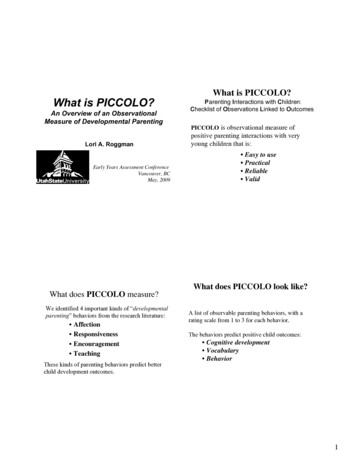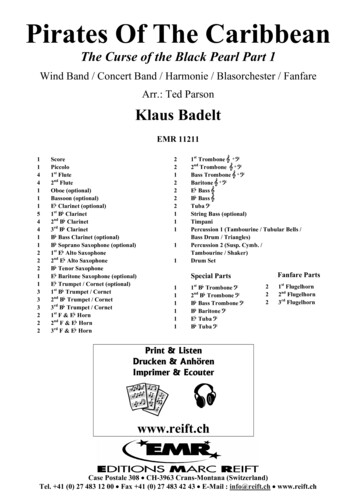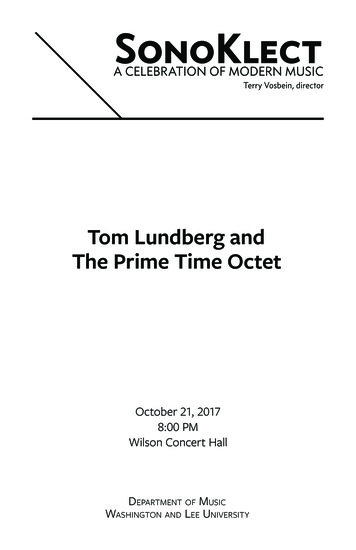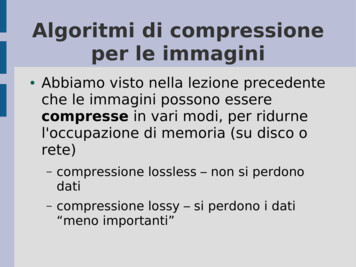
Transcription
What is PICCOLO?An Overview of an ObservationalMeasure of Developmental ParentingLori A. RoggmanEarly Years Assessment ConferenceVancouver, BCMay, 2009What does PICCOLO measure?We identified 4 important kinds of “developmentalparenting” behaviors from the research literature: Affection Responsiveness Encouragement TeachingThese kinds of parenting behaviors predict betterchild development outcomes.What is PICCOLO?Parenting Interactions with Children:Checklist of Observations Linked to OutcomesPICCOLO is observational measure ofpositive parenting interactions with veryyoung children that is: Easy to use Practical Reliable ValidWhat does PICCOLO look like?A list of observable parenting behaviors, with arating scale from 1 to 3 for each behavior.The behaviors predict positive child outcomes: Cognitive development Vocabulary Behavior1
“I saw things I didn’tsee before.”“It highlights parents’ skills.”“It works for me andmy families.”“It’s cutting edgein the 0-3 range”“It works in my community.”What do practitioners say aboutPICCOLO?“It’s a good tool forparents to understandtheir importance”“It’s easy to learn &really user friendly!”“It makes it easier to makelesson plans & help parents” to assess parenting skills to guide parenting interventions to track program outcomes“It gives me a starting pointfor what to do with parents”How was PICCOLOdeveloped? Used data &video archivemostly fromnational EarlyHead StartResearch &EvaluationProjectWhy use PICCOLO?Each domain has a list of 7-8 behaviors.For example: Collected new data from4,500 clips of2,000 families Selected best29 items from100 items2
Each item has coding guidelinesEach item is scored as 0, 1, or 2Scoring0 – “None” - Absent; didn’t see, not observed.1 – “Some” - Barely there; seen sometimes.2 – “Lots” - Consistently there; seen often.PICCOLO is . . . Positive: PICCOLO items describe positiveparenting. Practical: PICCOLO helps practitioners identifyparenting strengths to encourage parents to do more.Culturally Relevant:PICCOLO wasdeveloped from videotaped parenting interactions of European-Americans Latino-Americans African-Americans PICCOLO is . . . Reliable: Independent observers rate PICCOLOitems similarly, over 70% agreement across all ethnic groups 2 of 3 observers agree over 90% of the time inter-rater reliability, r .85and PICCOLO domain items “hang together” alpha .70 across domains & ethnic groups single factor structure within each domain3
PICCOLO is . . . Valid: PICCOLO has good content, construct,and predictive validity. content validity: practitioners’ importance ratings construct validity: correlations with similarmeasures predictive validity: correlations with child outcomesConstruct ValidityIn all age (14m, 24m, 36m) & ethnic groups, similarmeasures are correlated with PICCOLO domains:Content ValidityPractitioners rated each PICCOLO item on 0-3 scale0 not at all important1 somewhat important2 fairly important3 very importantSelected items averaged 2.6, eliminated items 2.3.Average importance Affection2.7 Responsiveness2.6 Encouragement2.6 Teaching2.4Predictive ValidityPICCOLO correlates with the following outcomes,at various times, for all ethnic groups: Affection with positive regard, r .50 Responsiveness with sensitivity, r .39 Teaching/Talking with cognitivestimulation, r .50 Cognitive development Vocabulary Behavior Encouragement with supportiveness*, r .504
Affection is related toDomain 1: AffectionDefinition: Warmth, physical closeness, andpositive expressions toward child. less antisocial behavior better adjustment more compliance greater cognitive ability more school readinessResearch by Caspi, et al. (2004),Dodici et al. (2003), Estradaet al. (1987), MacDonald (1992), Petrill et al., (2004), andSroufe et al. (1990).Affection itemsDomain 2: ResponsivenessDefinition: Responding to child’s cues, emotions,words, interests, and behaviors.5
Responsiveness is related toResponsiveness items more secure attachment better cognitive & social development better language development fewer behavior problems better emotion regulation & empathyResearch by Bornstein & Tamis-LeMonda (1989),Davidov &Grusec (2006), Landry et al. (2001), Spencer & MeadowOrlans (1996), Tamis-LeMonda et al. (2001), Volker et al.,(1999), and Wakschlag & Hans (1999).Domain 3: EncouragementDefinition:Active support of child’sexploration, effort, skills, initiative, curiosity,creativity, and play.Encouragement is related to less negativity willingness to try challenging tasks better cognitive & social development better language developmentResearch by Frodi et al. (1985), Ispa et al. (2004), Hart &Risley (1995), Landry et al. (1997), and Kelly et al. (2000).6
Encouragement itemsDomain 4: TeachingDefinition:Shared conversation and play,cognitive stimulation, explanations, and questions.Teaching itemsTeaching is related to better cognitive & social development better language development more conversation more emergent literacy skillsResearch by Baumwell et al., (1997), Carpenter et al., (1998),Hart & Risley (1995), Hockenberger et al. (1999), Laasko etal. (1999), and Tamis-LeMonda et al., (2001).7
HOW TO USE PICCOLOWITH FAMILIESHow do I select PICCOLOobservation activities?Select activities that . . . fit program goals can be done in limited space engage both parent and child last at least 10 minutes(or any parenting observation measure)Activities for PICCOLOobservations Picture books (Hungry Caterpillar, GoodNight Moon, etc.) Puzzles, blocks, play-dough, art materials Pretend play toys Family routines Planned home visit activitiesTips for doing PICCOLOObservations with Families Tell parents you’ll do observations regularly. Be flexible--re-schedule if needed. Offer choices of activities. Do the observation where the family is comfortable. If video recording, offer a copy of the video.8
When to do PICCOLO Ratings “Live” * Immediately after home visit--while memorable Later while watching video (most common) alone--identify strengths to support with parent--evidence-based intervention with supervisor--for reflection and planningWhen you use PICCOLO with parents be. . .Positive: Emphasize what parents do well and often.Video-recording Guidelines Set up in a quiet place. Both parent and child in viewfinder. Faces, hands, materials in viewfinder. Don’t face a light or sunny window! Check viewfinder Record for 10 minutes. Check viewfinderHow to use PICCOLO to plan intervention1. Look for highest PICCOLO domain & itemscores.Practical: Ask when parents can do morePICCOLO behaviors as part of regular activities.2. Ask what daily activities involve those behaviors.Culturally Sensitive: Ask parents what kinds of3. Plan with parent to do that activity on a home visit.parenting interactions are important to them.4. During activity, ask about related parentingbehaviors in that and other domains.9
Strategies that work with PICCOLO Focus on child development Engage parent & child together Observe & comment on PICCOLO behaviors Plan activities together Involve the family in activities Use family activities & routines Be responsive, flexible,& supportivePICCOLOParenting Interactions withChildrenChecklist of ObservationsLinked to OutcomesSupport materialsavailable for PICCOLOMeasuring theHigh Notesof ParentingInteractionsUsers’ GuidePICCPICCOLO OLOTraining DVDT raining DVDFunded by ACYF Grant # 90YF0050PICCOLO ResearchersLori Roggman FaLori@cc.usu.eduMark Innocenti Minno@eiri.usu.eduGina CookVonda JumpJim AkersKatie ChristiansenCora PriceLauraMichele GardnerProgram PartnersBear River Head Start, Logan, UTDavis Early Head Start, Layton, UTGuadalupe Schools Early Childhood Program, SLC, UTThanks!We are grateful to the parents and children in thevideo clips used to develop the PICCOLO measure.Many of them were in the Early Head Start researchproject. We are also grateful to the Early HeadStart Research Consortium and the Head StartBureau for making those video clips available forresearch and to the Administration for ChildrenYouth & Families for making the PICCOLOproject possible through Grant #90YF0050.10
Used data & video archive mostly from national Early Head Start Research & Evaluation Project Collected new data from 4,500 clips of2,000 families Selected best 29 items from 100 items Each domain has a list of 7-8 behaviors. For example: 3 Each item has coding guideline



![Rubank elementary method : [for] flute or piccolo](/img/5/rubankelementary-flute.jpg)






